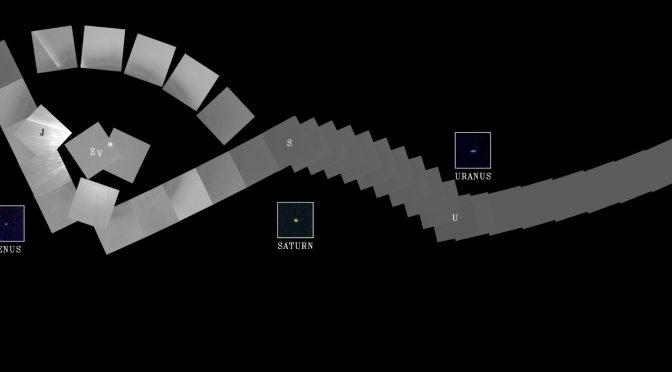
I figured I’d ride the coattails of the pop sci news and take a brief moment to discuss some data that’s recently come in from humanity’s most distant emissary. The two Voyager spacecraft were launched from Earth in the summer of 1977 with the mission of exploring the outer planets of the Solar System. Voyager 2 (ironically, the first of the two probes launched) visited Jupiter, Saturn, Uranus and Neptune, and is still the only manmade object to have visited the latter two planets. Voyager 1 visited Jupiter and Saturn and swung in for a close flyby of the Saturnian moon Titan. The pull of Titan’s gravity altered Voyager 1’s trajectory just enough to send it veering off on a course that would cause it to miss the other outer planets. Voyager 1’s main mission of observing the Jovian and Saturnian systems ended on December 14, 1980, just over three years after it had launched. It quietly continued to cruise, occasionally beaming back data from its various particle detectors for another 3 decades or so until, on August 25, 2012, at nearly eleven and a half billion miles from home, it sailed right out of the Solar System.
Or so some people think. Over the past few days, a private debate between the scientists involved in the Voyager program has become public. A new paper has been accepted into Geophysical Research Letters asserting that Voyager 1 crossed the tenuous property line between “Solar System” and “Interstellar Space” sometime near the end of last summer. How do they know it? Well, here’s their evidence:

These two graphs are data feeds from the particle detectors on board Voyager 1. The top graph shows the number of charged particles, such as protons, coming from the direction of the Sun. This is commonly referred to as the solar wind, since the Sun is constantly blowing off streams of charged particles. The bottom graph shows the number of charged particles coming from interstellar space. These are commonly referred to as cosmic rays. Starting around late July 2012, we see that the particle detectors began observing some really odd behavior. Then, abruptly in late August, the number of particles detected from the solar wind dropped to nearly nothing, while the number of cosmic rays coming from interstellar space hopped up by about 10-15%. The authors of the new paper point to this dramatic change in Voyager 1’s environment as clear evidence that the spacecraft is no longer in an environment in which the Sun is the dominant body; that is to say, Voyager 1 has left the Solar System.
But the directors of the Voyager mission at NASA see things differently. Their view is that Voyager 1 is still inside the Solar System because the magnetic field it feels is still emanating from the Sun. Once the Sun’s magnetic field is no longer dominant, these scientists hypothesize that the field will abruptly shift directions and intensity and we’ll truly know that Voyager 1 is outside the Sun’s bailiwick.
So who’s right? We might not have to wait very long for an answer: Voyager 1 is screaming out of the Solar System at over 10 miles per second. That kind of speed would cut the flight from Boston to LA down to just under six minutes. If the NASA folks are right, we should see that magnetic field change we’re all looking for within the next few years at the most. Then again, if the GRL folks are right, we might just be waiting around for nothing. And we don’t have forever to wait, either. Right now, both Voyager probes get their power from radioisotope thermoelectric generators, which are basically heat engines that rely on slowly decaying plutonium as a power source. As the plutonium gets used up, it gradually cools. Around 2025, the radioactive core of the probes will no longer generate enough heat to power any single instrument. Silent, dark, billions and eventually trillions of miles from anything, the Voyagers will freeze to death on the edge of our Solar System. At least until zombie Gene Roddenberry catches up to them.
References
Most of the stuff here came straight from NASA’s pages on the Voyager mission:
The Geophysical Research Letters paper can be found here:
